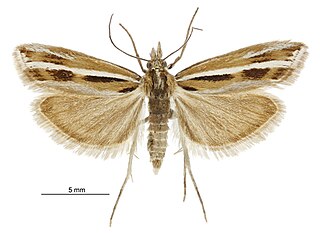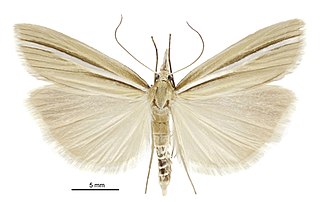
Crambidae comprises the grass moth family of lepidopterans. They are variable in appearance, with the nominal subfamily Crambinae taking up closely folded postures on grass stems where they are inconspicuous, while other subfamilies include brightly coloured and patterned insects that rest in wing-spread attitudes.

The Pyraloidea are a moth superfamily containing about 16,000 described species worldwide, and probably at least as many more remain to be described. They are generally fairly small moths, and as such, they have been traditionally associated with the paraphyletic Microlepidoptera.

Crambinae is a large subfamily of the lepidopteran family Crambidae, the crambid snout moths. It currently includes over 1,800 species worldwide. The larvae are root feeders or stem borers, mostly on grasses. A few species are pests of sod grasses, maize, sugar cane, rice, and other Poaceae. The monophyly of this group is supported by the structure of the tympanal organs and the phallus attached medially to the juxta, as well as genetic analyses.

Ancylolomia is a genus of moths of the family Crambidae described by Jacob Hübner in 1825.
Caffrocrambus is a genus of moths of the family Crambidae.

Calamotropha is a genus of moths of the family Crambidae.
Classeya is a genus of moths of the family Crambidae.

Culladia is a grass moth genus of subfamily Crambinae, tribe Crambini. Some authors have assigned the synonymous taxon Nirmaladia to the snout moth family (Pyralidae), where all grass moths were once also included, but this seems to be in error.
Gargela is a genus of moths in the subfamily Crambinae of the family Crambidae. The genus currently comprises 22 Austral-Asian species, of which the majority has been described in recent years. Many species remain to be described, with their total number probably being around 40 species.
Malgasochilo is a genus of moths of the family Crambidae. It contains only one species, Malgasochilo autarotellus, which is found in Madagascar. The forewings of this species are dull-greyish brown with a length of 12 mm.

Orocrambus flexuosellus is a species of moth in the family Crambidae. It was first described by Edward Doubleday in 1843. O. flexuosellus is endemic to New Zealand. It has been recorded from the North Island, South Island and the Stewart Islands. The species' habitat consists of lowland to alpine grasslands.
Chrysocatharylla is a genus of moths of the family Crambidae.

Orocrambus corruptus is a moth in the family Crambidae. It was described by Arthur Gardiner Butler in 1877. It is endemic to New Zealand. It is known from the lowland and intermontane region areas of eastern and central South Island. The habitat consists of poorly drained areas up to 750 meters and old pastures.

Orocrambus cyclopicus is a moth in the family Crambidae. It was described by Edward Meyrick in 1883. In 1975 David E. Gaskin wrongly synonymised Crambus sophistes with Orocrambus cyclopicus.

Orocrambus geminus is a moth in the family Crambidae. It was described by Brian H. Patrick in 1991. It is endemic to New Zealand. The species has been recorded in Central Otago. The habitat consists of wet low alpine areas.

Orocrambus heliotes is a moth in the family Crambidae. It was described by Edward Meyrick in 1888. This species is endemic to New Zealand. O. heliotes has been recorded in the South Island and the North Island. The habitat it prefers consists of swampy tussock grasslands and margins of slow-moving streams.

Orocrambus ramosellus is a moth in the family Crambidae. It was described by Henry Doubleday in 1843. It is endemic to New Zealand, where it has been recorded in the North and South Islands. The habitat of this species consists of pastures.

Orocrambus simplex is a moth in the family Crambidae. It was described by Arthur Gardiner Butler in 1877. It is endemic to New Zealand, where it has been recorded in Westland, Nelson Province, the central part of the North Island and the coastal area of southern Hawkes Bay. The habitat where this species lives consists of tussock grasslands.

Orocrambus vittellus is a moth in the family Crambidae. It was described by Henry Doubleday in 1843. It is endemic to New Zealand. This species has been recorded in the North and South Islands, as well as Stewart Island. It prefers a habitat that consists of grasslands.

Orocrambus vulgaris is a moth in the family Crambidae. It was described by Arthur Gardiner Butler in 1877. It is endemic to New Zealand, where it has been recorded from the North Island and South Island. The species prefers habitat that consists of lowland and subalpine grasslands.














